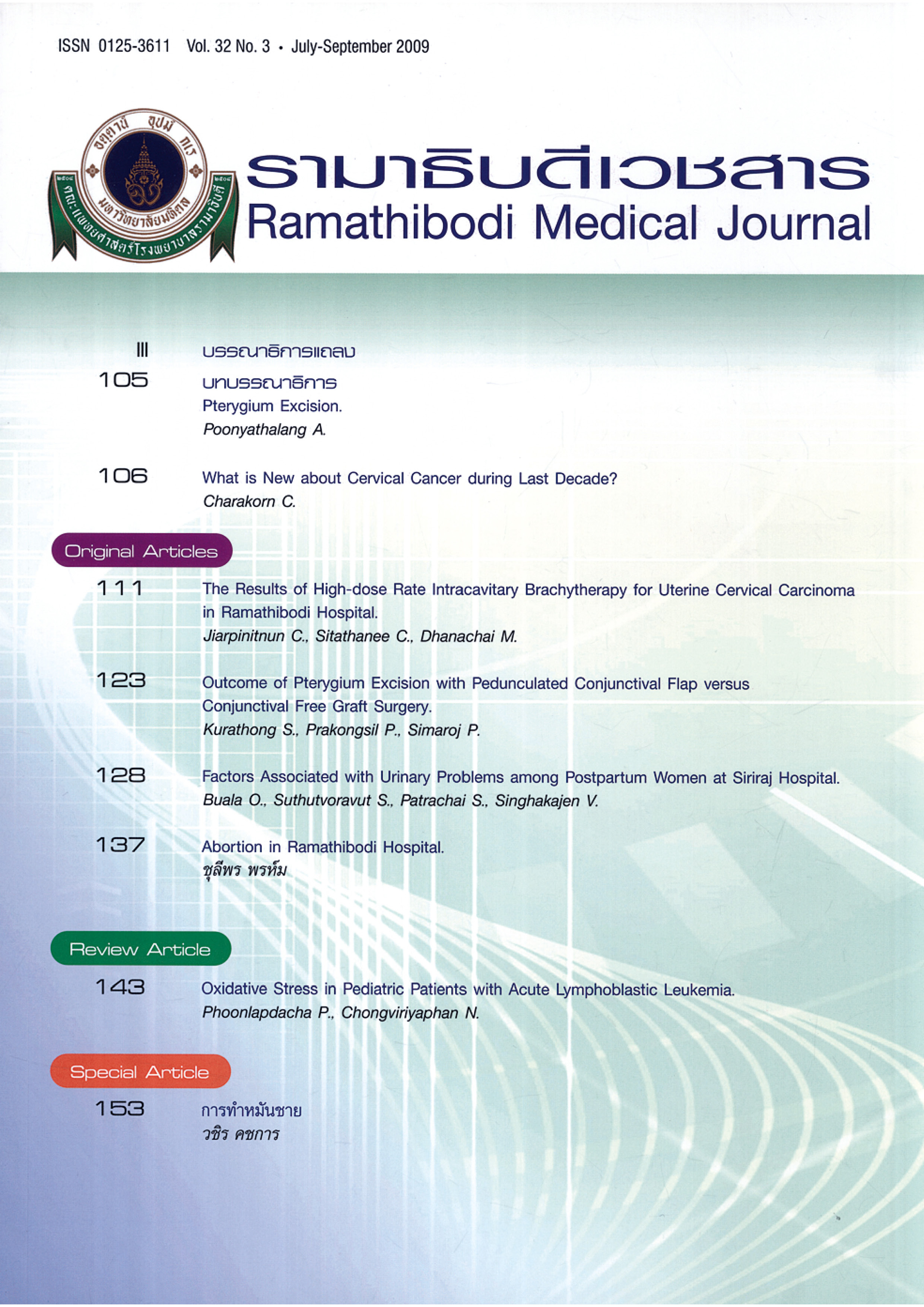Outcome of Pterygium Excision with Pedunculated Conjunctival Flap versus Conjunctival Free Graft Surgery
Keywords:
Pterygium excision, Pedunculated conjunctival flap, Conjunctival free graftAbstract
Purpose: To compare the surgical time and recurrence rate of pterygium excision with pedunculated conjunctival flap and conjunctival free graft surgery in primary pterygium.
Methods: A nonrandomized prospective control study was performed in 45 eyes of 39 patients with pterygium from July 2006 to July 2008. Six patients had bilateral pterygium and 3 patients had double-head pterygium which pterygium excision with pedunculated conjunctival flap was performed at nasal site and conjunctival free graft at temporal site. Twenty-eight operations were performed by pedunculated conjunctival flap technique (group A) and 20 operations were performed by conjunctival free graft technique (group B)
Results: There were 26 females (66.7%) and 13 males (33.3%). Pterygium involved right eye in 20 cases (44.4%) and left eye in 25 cases (55.6%). The mean age was 64 years, range 34-88 years. The mean followed-up time was 9.2 months, range 3-20 months, The average surgical time in group A was 35,83 minutes (range 20-60 minutes) that was significantly less than 65 minutes (range 35-90 minutes) in group B (p = 0.000). There was no significant difference of recurrent rate in group A (7.14%) and group B (20%) (p = 0.184).
Conclusion: Although pedunculated conjunctival flap and conjunctival free graft surgery are both effective to reduce recurrence rate after pterygium surgery, the pedunculated conjunctival flap is more conjunctival-preserved and less surgical time consuming. This technique can be an alternative procedure for pterygium surgery, especially for glaucoma patients.
References
Horatanaruang O, Tanchotikul S. Combine bare sclera and pedunculated conjunctival flap for the treatment of pterygium. Thai J Ophthalmol. 2006;20:53-60.
Dupps WJ Jr, Jeng BH, Meisler DM. Narrow-strip conjunctival autograft for treatment of pterygium. Ophthalmology. 2007;114(2):227-231. doi:10.1016/j.ophtha.2006.08.040.
Tan DT, Chee SP, Dear KB, Lim AS. Effect of pterygium morphology on pterygium recurrence in a controlled trial comparing conjunctival autografting with bare sclera excision. Arch Ophthalmol. 1997;115(10):1235-1240. doi:10.1001/archopht.1997.01100160405001.
Wu WK, Wong VW, Chi SC, Lam DS. Surgical management of double-head pterygium by using a novel technique: conjunctival rotational autograft combined with conjunctival autograft. Cornea. 2007;26(9):1056-1059. doi:10.1097/ICO.0b013e31813349ec.
Jap A, Chan C, Lim L, Tan DT. Conjunctival rotation autograft for pterygium. An alternative to conjunctival autografting. Ophthalmology. 1999;106(1):67-71. doi:10.1016/S0161-6420(99)90006-4.
Ang LP, Chua JL, Tan DT. Current concepts and techniques in pterygium treatment. Curr Opin Ophthalmol. 2007;18(4):308-313. doi:10.1097/ICU.0b013e3281a7ecbb.













